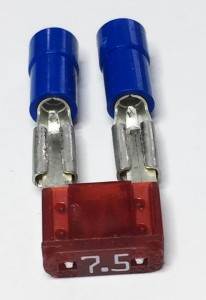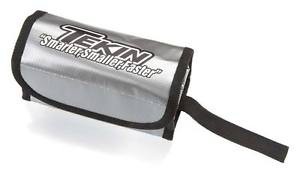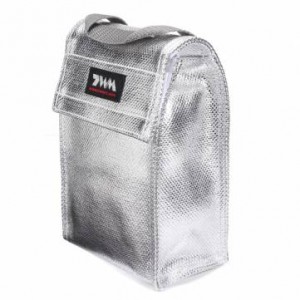Lithium based batteries can give you high power transfer very quickly and with lower weight than traditional rechargeable batteries, but you need to manage this extra power very carefully. This page offers some tips on how to make your robot work safely using Lithium based power supplies.
First, Calculate the power drain of your robot to establish fuse size.
Second, Check what minimum wire gauge you may safely use.
Third, Find a suitable shutoff switch.
Fourth, Design your chassis to hold motors, wheels, battery pack (as central as possible to avoid damage from other robots) circuit boards, shutoff switch, and finally sensors and any defensive devices such as a scoop/bumper/wheelies/etc.
Fuses
To calculate the minimum fuse size, use the following formula:
(stall amps of largest motor) x (# of motors used) x (multiplier 1.5) = Minimum fuse rating. Choose the next largest fuse size. E.g. (2.2 stall amps)(2 motors)(1.5)= 2.2 * 2 * 1.5 = 6.6 Amps. As Mini® series automotive fuses come in 2, 3, 4, 5, 7.5, 10, 15, 20, 25, & 30 Amps, and there is no 6.6 Amp fuse, therefore the next larger you can use would be a 7.5 Amp fuse.
You can use glass/ceramic fuses (Type AGA, AGW, AGC) or the more modern Blade style automotive fuses. If you are tight for space, as on a Mini Sumo then the Mini® series are small, light weight and although sockets are hard to come by you can use insulated 0.110″ spade connectors. Note* the spade connectors are designed to grip metal terminals that are 0.5mm thick while the Mini fuse terminal is 0.82mm thick so you will need to open them up slightly with a small flat screwdriver.
Wire size
Don’t use the wrong wire size! Too small a wire gauge will act as a fuse also but it will get hot first and may easily cause a fire. The current rating of the fuse should be the minimum considered when selecting the correct wire size. As a guide, use 16 AWG wire up to 15 Amps, 14 AWG up to 25 Amps and 12 AWG up to 30 Amps. To calculate voltage drop try: http://www.calculator.net/voltage-drop-calculator.html
Shut off switches
Be sure to either use a switch that can handle the full power that you have calculated, or use a small switch that trips a relay, SCR or power transistor. Shut off the power as close to the battery as possible, but at the very least it should stop the robot from moving.
Mounting and charging your power pack
A punctured or shorted Lithium polymer battery is a potential incendiary device. PROTECT from being punctured. PROTECT from having the leads shorted. Always use the polarized connectors that came with the battery pack, and never modify them unless approved by your instructor.
Additional guidelines to ensure the safety of you and your robot
Never put Li-Ion or Li-Po cells in series. If you need a higher voltage then purchase a “Brick” or “Pack” of the desired voltage/Amp hr rating which is a series of cells that have been assembled in a factory and contain circuitry to ensure even charge and discharge.
Only use a charger designed for the specific type and size of Li-Ion or Li-Po Battery.
Never leave charging Li-Ion or Li-Po Batteries unattended.
Do not overcharge lithium polymer batteries. (Please refer to your manual for overcharge limits).
Never charge a Li-Ion or Li-Po battery at a faster rate than recommended.
If the battery becomes hot to touch, switch off immediately.
When a Li-Po battery becomes unstable, it generates heat very rapidly so to be safe purchase a “Li-Po safe charger bag”, preferably one with a handle or strap(Eliminator-RC had one for $20.99). 
 Then if one does go unstable, the bag will contain the exothermic reaction, though not the smoke. If the charging bag has a handle, grab it, hold it away from your body and get outside as quickly as possible. The charging bag should be used to store Li-Po batteries when not in use, as well as when charging.
Then if one does go unstable, the bag will contain the exothermic reaction, though not the smoke. If the charging bag has a handle, grab it, hold it away from your body and get outside as quickly as possible. The charging bag should be used to store Li-Po batteries when not in use, as well as when charging.
Be extra vigilant when carrying or connecting batteries to ensure that the battery leads are not allowed to be shorted.
Always store Li-Ion or Li-Po batteries in a safe place, such as a Li-Po safe charging bag or a sturdy, non-conductive box.
Only charge the batteries on a non-flammable non-conducting surface.
Do not charge the battery inside or near flammable material.
An area will be designated specifically for charging Li-Ion and Li-Po batteries as this will have sand and easy access to the outside in case of problems. Only NiCad and NiMH batteries will be allowed to be charged in the pit area
Never touch a swollen or smoking battery with your fingers, use tongs.
